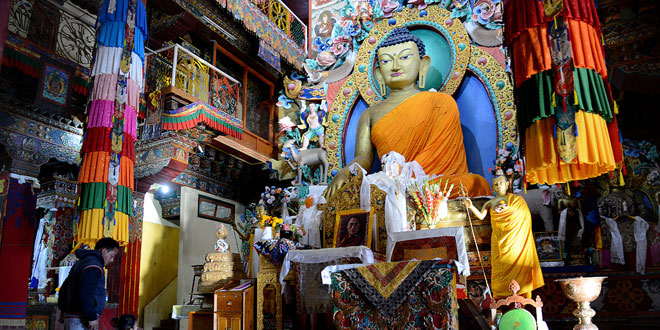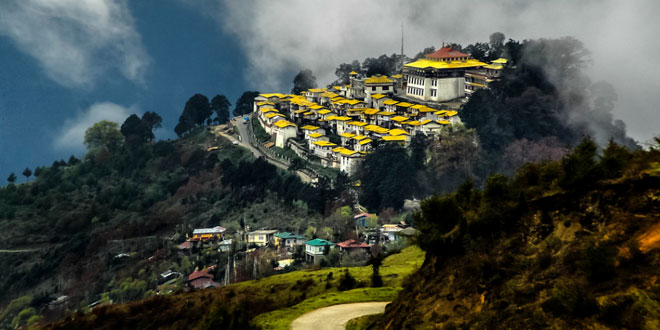
History Of Tawang
Tawang Monastery, which literally means ‘Horse Chosen’, was founded in the 17th century by Mera Lama Lodre Gyatso, fulfilling the wish of Nagwang Lobsang Gyatso, the fifth Dalai Lama. The name Tawang is associated with a legend. Considering Dalai Lama’s wish, Mera Lama decided to make a monastery but, even after searching for long, he was unable to find a suitable place for the monastery. Finding no other way, he decided to take divine guidance and prayed in a cave, keeping his horse outside. Coming out after his prayer, he found his horse missing and started searching for it. After a long search he found the horse standing on a hilltop. Mera Lama considered this to be a clue from the divine power and decided to build the monastery there. The villagers from the neighboring villages volunteered to give shape to the Dalai Lama’s wish and thus this wonderful monastery came into existence. Since then, it has been an important Buddhist centre spreading Buddhism in that area. Some parts of this monastery have been destroyed by Chinese soldiers during Indo-China war. The monastery is now under the threat of landslide as the toe of the hill is being eroded by the river.
Major Attractions
The entrance gate is known as the ‘kakaling’. This hut-like structure, which is supported by two lateral stone-walls, serves as a gate to the monastery. The ceiling of the kakaling is beautifully painted with Kying-khors (Mandalas), while the inside walls are given still distinct appearance with murals of deities and saints. The kakaling leads you to a big gate situated further south. ‘Dung-Gyur Mani’, situated outside the main gate, is noteworthy as it is from here that the monks fetch water to the monastery. The main gate of the monastery stands further south of kakaling and is fitted with huge doors. There is another gate situated near the southern end of the eastern wall which has a huge door attached. You can see two slits in the wall, which is meant to see out and attack any approaching enemy with a muzzle-loaded gun. The eastern wall is connected with the kakaling by a narrow path. It is believed that the area enclosed in the four walls represent the area covered by the yarn given by the 5th Dalai Lama to Mera Lama to find a place for the monastery.
There are many structures inside the monastery which makes it appears like a fort when viewed from a distance. The court of the monastery hosts religious dances and outdoor ceremonies and it is surrounded by many buildings. There are sixty residential quarters for the monks and they are called sha (hut). On the western side of the court stands the three-storied library known as Par-Khang, which contains many important and rare religious manuscripts including the Holy Scriptures. A part of the two-storied building on the southern side is used to store provisions while the other part is occupied by Dra-tsang buk and his entourage. To the northern side stands the assembly hall which has a temple and the ‘Labrang’, which is the establishment of the abbot.
‘The Centre for Buddhist Cultural Studies’ functions in the monastery, which is dedicated to conduct Buddhist cultural studies, and to educate young monks on Mathematics, English, Hindi and Monastic education. The Tawang monastery is also known for the huge gilded statue of Lord Buddha. The major festivals celebrated in this monastery are Losar (Tibetan New Year according to the lunar calendar), Torgya, Saka Dawa (enlightenment day of Buddha), Dukpa Tse-Shi (to commemorate the first sermon of Buddha), Lhabab Duechen (to commemorate the reincarnation of the Buddha in His Shakyamuni form) and Ganden Ngamchoe (the death anniversary of Tsongkha-Pa, the founder of the Gelugpa sect).
The best season to visit Tawang is between October and April. You can also visit Urgelling Monastery, Rigyalling Monastery, Taktsang Monastery, Tawang Memorial and Pangang-Tang-Tso which are the other important Buddhist centers situated near Tawang.
How to Reach Tawang
By Air:
The nearest airport is at Tezpur (Assam), which is at a distance of 365 kilometers. Tezpur is directly connected to Kolkata (West Bengal) by two flights weekly. Another option is Guwahati (Assam) which is 555 kilometers away from Tawang and is connected to different parts of the country by daily flights.
By Train:
Guwahati, located at about 555 km from Tawang has the nearest rail station, which is also connected to all the major cities in India.
By Road:
State transport and private bus services are available to reach Tawang. Commercial taxi services are also available. The nearest bus services are from Bomdila (185 km), Tezpur (365 km) and Guwahati (555 km).
Tawang monastery is one of the most important Buddhist shrine located in a scenic backdrop in the lap of the majestic mountains and is worth visiting at least once in a life-time. It has a rich Buddhist culture and many fairs and festivals are organized at various times of the year. Visiting Twang can indeed be a fulfilling experience.
 Kids Portal For Parents India Kids Network
Kids Portal For Parents India Kids Network







